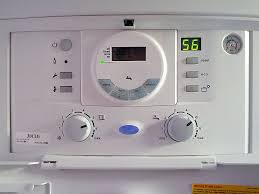Heating Controls – take control of your bills while keeping warm this winter

It’s now that time of year when we are all starting to put on our central heating as the outside temperature is dropping and the evenings are getting longer. Using your heating controls effectively will reduce your energy consumption while ensuring your home is heated to the correct and most comfortable temperature.
Here our expert energy advisor Brian explains the different heating controls for a central heating system and how to get the most from it this winter. Controls for your heating system fall into two different categories:
- Temperature Controls
- Timing Controls
So what are the benefits of heating controls?
According to the Energy Saving Trust there are a number of benefits to fitting good heating controls. Some of which are:
- You can schedule when your heating comes on and off giving you better control of costs
- You can heat rooms to different temperatures with TRV (Thermostatic Radiator Valves)
- Average savings for a typical 3 bedroom home heated by gas is:
| Action | Potential Savings per year |
| Installing and correctly using a room thermostat and TRV radiator controls | £80-£165 Year |
| Fitting a hot water tank jacket | £25-£35 year |
| Keeping your room thermostat between 18-21 degrees | £85-£90 year |
Temperature Controls
Room Thermostats
This controls the temperature to which the heating system will heat the air. When the air temperature reaches the desired temperature set on the thermostat the boiler switches off. It will come back on again when the temperature falls below the desired temperature.
It is recommended to keep your thermostat setting between 18-21 degrees to work most efficiently. For older occupants that are less mobile this should be increased to about 22-23 degrees. A common misconception is that turning your room thermostat up to full will heat the house quicker. Your boiler only works at one speed and turning the temperature up to full only wastes fuel and makes the house uncomfortably hot.
Some modern heating controls now combine the timer and the thermostat, allowing you to set different temperatures for different times of the day.
Thermostatic Radiator Valves (TRV’s)

Thermostatic Radiator Valves allow you to control the temperature of a room by regulating the flow of water through the radiator. These usually have temperature settings from 1 to 5. If, for example, during the day you spend most of your time downstairs, you could set the TRVs on the downstairs radiators to around 3 or 4, and leave the upstairs radiators on 2.
Turning radiators off completely in individual rooms is not a good practise, as very cold rooms can develop damp and mould. Instead, set the radiators in rooms you’re not using to low, and keep the door closed.
Cylinder Thermostats

For systems where your hot water is stored in a cylinder, the thermostat will prevent it becoming hotter than it needs to. Once the water has reached the temperature you have set, the heat supply from the boiler will be turned off.
Cylinder thermostats are usually fitted on the side of your water cylinder. They have temperature scales marked; you should set them at between 60 and 65 degrees.
Boiler Thermostat

Your boiler will usually have a dial on it, marked in numbers or from Min to Max. This sets the temperature of the water that will be pumped from the boiler through the radiators. The higher this is set, the quicker and more effectively the system will heat your home.
Modern boilers will have a digital dial where you can set the output temperature. For combi boilers it is recommended to set the output temperature for the radiators at 75 degrees and the water temperature at 60 degrees.
Temperature Controls
Programmer or timing control

A timer or programmer allows you to control when you’re heating and hot water come on and when it goes off. You can programme the heating to come on at different times of the day for each day of the week. There is usually a manual override button if you want the heating to come on early. Check that the timer on the programmer is correct before you set your programmes.
Set your water to heat up only when you need it. A hot water cylinder or tank that is well insulated will keep the water warmer for longer and so reduce the amount of time you need to heat it.
So what do all the controls on my programmer do?
- ‘Auto’ or ‘Twice’ means the heating will go on and off during the day at the times it has been programmed to do so.
- ‘24hrs’ or ‘On’ means the heating stays on constantly.
- ‘Off’ means the heating will remain off all the time.
- ‘All day’ or ‘Once’ means the heating will switch on at the first ‘on’ setting you have programmed and then remain on until the last ‘off’ setting of the day.
- ‘Boost’ or ‘+1hr’ switches the heating on for a one hour ‘boost’ of heat.
- ‘Advance’ moves the programmer to the next ‘on’ or ‘off’ setting in the daily cycle.
Don’t forget that the clocks go back an hour on Sunday morning, 25th October and so the time setting on your heating programmer will need to be adjusted accordingly.
Greener Kirkcaldy can help
Our Cosy Kingdom service offers free and impartial home energy advice. One of our energy advisors can come to your home and provide you with one to one help and advice.
For more information or to arrange a free home visit get in touch by calling 01592 858458, emailing info@greenerkirkcaldy.org.uk or pop into our High Street Hub, 254a High Street, for a chat Wednesday to Saturday, 10am-4pm.
|